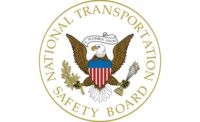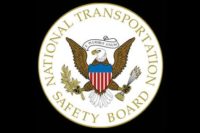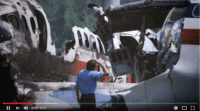Planes, trains and automobiles…and drones…were frequently in the news this year. Accident investigations found fatigue, substance misuse and bad decisions behind a number of transportation-related accidents. Regulators attempted to keep pace with the development of autonomous vehicles and the growing popularity of drones. Here are the top transportation safety stories of 2017.
80 mph in a 30-mph zone
Amtrak train that derailed was speeding
December 19, 2017
The train that derailed outside Tacoma, Washington early yesterday, killing three people and injuring scores more, was going 80 miles an hour in a section of track designed for 30-mile-an-hour speeds, according to the National Transportation Safety Board (NTSB), which is investigating the incident. News sources say that while rounding a corner and heading toward a bridge, the train jumped the tracks and slammed into a ditch, spewing some of its 12 cars across a highway where they came into contact with five cars and two trucks.
Drone operator caused drone, helicopter collision
December 15, 2017
The National Transportation Safety Board (NTSB) has determined that the operator of a drone that collided with an U.S. Army helicopter failed to see and avoid the helicopter because he was intentionally flying the drone out of visual range and did not have adequate knowledge of regulations and safe operating practices.
NTSB: Poor decisions, lax safety oversight led to sinking
December 14, 2017
The deadliest shipping disaster involving a U.S.-flagged vessel in more than 30 years was caused by a captain’s failure to avoid sailing into a hurricane despite numerous opportunities to route a course away from hazardous weather, the National Transportation Safety Board (NTSB) announced during a public meeting Tuesday. The cargo vessel S.S. El Faro sank Oct. 1, 2015, in the Atlantic Ocean during Hurricane Joaquin, taking the lives of all 33 aboard.
A FairWarning story
Amid rush to deploy driverless cars, federal regulators urged to keep hands on the wheel
December 7, 2017
The era of driverless vehicles appears to be rapidly approaching, raising a bevy of urgent questions about how to prevent the emergence of new hazards on the nation’s roads. So, how much preparation have federal transportation authorities carried out to meet the challenge of the advent of self-driving cars and trucks? Not nearly enough, according to a new 44-page report by the Government Accountability Office, a Congressional watchdog agency.
Highway, marine and railway deaths increase in 2016
November 22, 2017
Data released by the National Transportation Safety Board (NTSB) yesterday revealed that 2,030 more people died in transportation accidents in 2016 than in 2015, with highway fatalities accounting for 95 percent of all transportation fatalities in 2016. The data indicate 39,339 people lost their lives in transportation accidents in 2016, compared to 37,309 who died in 2015. In addition to the increase in highway fatalities, increases were also seen in the marine and railroad sectors, with a slight decrease in aviation fatalities.
“Amtrak’s safety culture is failing”
Harsh criticism from NTSB after fatal train derailment
November 15, 2017
The National Transportation Safety Board (NTSB) has determined that the April 3, 2016, derailment of Amtrak train 89 near Chester, Pennsylvania was caused by deficient safety management across many levels of Amtrak and the resultant lack of a clear, consistent and accepted vision for safety. A backhoe operator and a track supervisor were killed, and 39 people were injured when Amtrak train 89, traveling on the Northeast Corridor from Philadelphia to Washington on track 3, struck a backhoe at about 7:50 a.m.
Airline pilot survey highlights need for mental health support
October 24, 2017
In March 2015, Germanwings Flight 9525 crashed into the French Alps, killing all 150 people onboard. An investigation found that the co-pilot deliberately steered the plane into the mountainside. It also revealed that he had a history of depression, although the airline company was unaware of this crucial information.
NTSB: Pilot caused Texas hot air balloon crash that killed 15
October 18, 2017
The pilot’s “pattern of poor decision-making” – which was likely exacerbated by the medications he was taking for multiple health problems – led to the July 30, 2016 hot air balloon accident in Texas that killed 15 passengers and the pilot.
U.S. traffic deaths increased in 2016
October 9, 2017
Fatalities caused by distracted driving decreased in 2016, while deaths related to other reckless behaviors – including speeding, alcohol impairment, and not wearing seat belts – continued to increase, according to new figures released by the U.S. Department of Transportation’s National Highway Traffic Safety Administration (NHTSA).
Civilian drone, U.S. Army helicopter collide over NYC
October 6, 2017
It didn’t take long for the National Transportation Safety Board to identify the operator of the drone that collided with an Army UH-60 helicopter east of Staten Island, New York on September 21st, 2017.
Australian searchers end hunt for missing Malaysia aircraft
October 3, 2017
Authorities in Australia have closed the book on a commercial aircraft that went missing three years ago and has never been found. In a final report published yesterday, the Australian Transport Safety Bureau (ATSB) said it would be impossible to determine the cause of the disappearance of Malaysia Airlines flight MH370 on March 8, 2014, without finding the remains of the aircraft.
Driver errors, overreliance on automation, led to fatal Tesla crash
September 13, 2017
The National Transportation Safety Board (NTSB) has determined that a truck driver’s failure to yield the right of way and a car driver’s inattention due to overreliance on vehicle automation are the probable cause of the fatal May 7, 2016, crash near Williston, Florida.
Planes run out of fuel more often than you think
August 30, 2017
Better fuel management by aviators could prevent an average of 50 general aviation accidents a year, according to the NTSB’s latest safety alert, ‘Flying on Empty,’ issued yesterday.
A FairWarning story
Unbelted rider in the back could kill someone in the front
August 4, 2017
People who don’t buckle up when they ride in the rear seat because they think it’s safer back there are wrong. Instead, they pose a serious danger to themselves and those riding up front, according to a new study and crash test video by the Insurance Institute for Highway Safety.
Feds consider regs to track, ID drones
July 14, 2017
Drones may be a relatively new type of aircraft, but they’re very much the focus of attention for federal rulemakers.
2 CSX workers struck, killed by train near D.C.
June 28, 2017
Two employees of CSX Transportation died last night after being struck by an Amtrak train in Northeast Washington, D.C.
Study: Truckers at high risk for sleep apnea
June 19, 2017
About 40% of commercial drivers may have obstructive sleep apnea (OSA), suggests a research review in the June Journal of Occupational and Environmental Medicine.
Crewmember fatigue causes fatal tugboat sinking
May 24, 2017
Inadequate manning and the resultant crewmember fatigue caused the March 12, 2016, sinking of the tugboat Specialist in the Hudson River, according to a report released Tuesday by the National Transportation Safety Board.
Driver who killed five bicyclists was impaired
May 17, 2017
Helmets and high visibility clothing were no help to a group of bicyclists when a Michigan man who was under the influence of several drugs got behind the wheel of his pickup truck on June 7, 2016.
Pickup driver was texting, on meds at time of 13-fatality crash
May 5, 2017
The driver of a pickup truck was texting before crashing into a bus in Texas and killing all 13 people in it, according to the preliminary report released by the National Transportation Safety Board NTSB about the March 29 accident near Concan, Texas.
A FairWarning story
Smartphone distractions, drinking help spur rising pedestrian death toll
April 4, 2017
Pedestrian deaths are surging across the nation, and analysts are putting much of the blame on drivers and walkers who are looking at their smartphones instead of watching where they are going. Tipsy walking also is part of the problem, with one in three victims legally drunk when they were struck and killed.
Hauling oil and gas one of the most dangerous jobs
March 22, 2017
Approximately four percent of crude oil and petroleum products were shipped by truck in 2012. Trucking over rough rural roads, often in extreme weather conditions, is one of the biggest dangers in the oil and gas industry.
Drone sightings in airport zones continue to rise
February 28, 2017
Reports of possible drone sightings to FAA air traffic facilities continued to increase during FY 2016, according to the Federal Aviation Administration (FAA). A recent list of pilot, air traffic controller, law enforcement and citizen reports of potential encounters with unmanned aircraft systems (UAS) – more popularly called “drones" from February through September 2016 shows 1,274 such reports, 874 for the same period in 2015.






